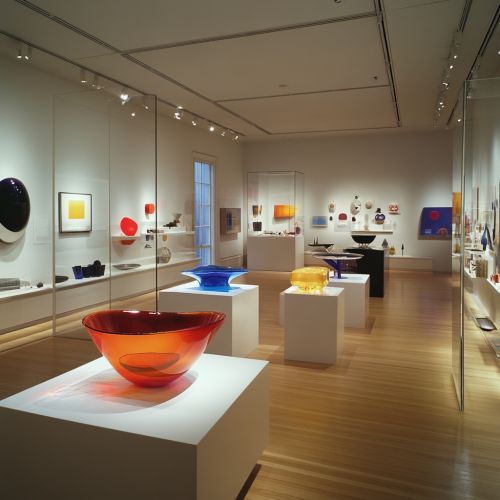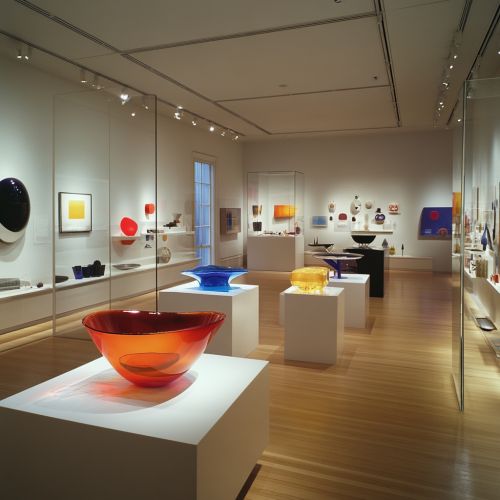Cooper Hewitt, Smithsonian Design Museum
History
The Cooper Hewitt, Smithsonian Design Museum, originally known as the Cooper Union Museum for the Arts of Decoration, was established in 1897 by Sarah and Eleanor Hewitt, granddaughters of industrialist Peter Cooper. The museum was founded as part of the Cooper Union for the Advancement of Science and Art, with the mission to educate and inspire through the arts of design and decoration. In 1967, the museum became part of the Smithsonian Institution, and in 1976, it was renamed the Cooper-Hewitt Museum of Decorative Arts and Design. In 2014, the museum underwent a major renovation and rebranding, emerging as the Cooper Hewitt, Smithsonian Design Museum.
Collections
The Cooper Hewitt, Smithsonian Design Museum boasts an extensive collection that spans over 250 years of design history. The collection is divided into several categories, including textiles, wallcoverings, drawings, prints, graphic design, product design and decorative arts. The museum's holdings include works by renowned designers such as William Morris, Frank Lloyd Wright, and Ettore Sottsass.
Textiles
The textile collection encompasses a wide range of materials, techniques, and periods. It includes examples of embroidery, weaving, printing, and dyeing from various cultures and time periods. Notable items in this collection include 18th-century French silk brocades, 19th-century American quilts, and contemporary textile art.
Wallcoverings
The wallcoverings collection features an array of wallpapers, borders, and other decorative wall treatments. The collection includes historic wallpapers from the 18th and 19th centuries, as well as modern and contemporary designs. Highlights include hand-painted Chinese wallpapers, French scenic wallpapers, and works by contemporary designers like Florence Broadhurst.
Drawings and Prints
The museum's collection of drawings and prints includes works by prominent designers and artists, such as Leonardo da Vinci, Albrecht Dürer, and Henri Matisse. The collection covers a wide range of design disciplines, including architecture, interior design, and industrial design. Noteworthy pieces include architectural renderings by Louis Sullivan, costume designs by Erte, and furniture designs by Charles Rennie Mackintosh.
Graphic Design
The graphic design collection at Cooper Hewitt encompasses posters, advertisements, book covers, and other printed materials. The collection highlights the evolution of graphic design from the 19th century to the present day. Key pieces include posters by Henri de Toulouse-Lautrec, advertisements by Paul Rand, and contemporary works by Stefan Sagmeister.
Product Design and Decorative Arts
The product design and decorative arts collection features a diverse array of objects, including furniture, ceramics, glass, and metalwork. The collection includes works by influential designers such as Charles and Ray Eames, Marcel Breuer, and Philippe Starck. Notable items include a Bauhaus tea service, Art Deco furniture, and contemporary lighting designs.


Exhibitions
The Cooper Hewitt, Smithsonian Design Museum hosts a variety of temporary and permanent exhibitions that explore different aspects of design. These exhibitions often feature objects from the museum's collection, as well as loans from other institutions and private collections. Recent exhibitions have included "The Jazz Age: American Style in the 1920s," "Nature—Cooper Hewitt Design Triennial," and "The Senses: Design Beyond Vision."
Education and Outreach
The museum is committed to education and outreach, offering a range of programs for visitors of all ages. These programs include workshops, lectures, and tours that aim to engage the public with the world of design. The museum also offers resources for educators, including lesson plans and professional development opportunities.
Design Camp
One of the museum's flagship educational programs is Design Camp, a summer program for middle and high school students. Design Camp provides hands-on learning experiences in various design disciplines, such as graphic design, product design, and architecture. Participants have the opportunity to work with professional designers and explore the museum's collection.
Cooper Hewitt Labs
Cooper Hewitt Labs is an initiative that focuses on the intersection of design and technology. The program includes workshops, hackathons, and other events that encourage experimentation and innovation. Cooper Hewitt Labs aims to foster collaboration between designers, technologists, and the public.
Research and Publications
The Cooper Hewitt, Smithsonian Design Museum is also a center for research and scholarship in the field of design. The museum's staff and affiliated scholars conduct research on the collection and related topics, resulting in publications, exhibitions, and public programs.
Scholarly Publications
The museum publishes a range of scholarly works, including exhibition catalogs, monographs, and journals. These publications contribute to the academic discourse on design and provide valuable resources for researchers, students, and the general public. Notable publications include "Designing Modernity: The Arts of Reform and Persuasion, 1885-1945" and "Wall Stories: Children's Wallpapers and Books."
Online Resources
In addition to print publications, the museum offers a wealth of online resources. The museum's website features a digital collection, allowing users to explore the collection online. The website also includes educational resources, such as lesson plans and interactive activities, as well as information about current and upcoming exhibitions.
Architecture and Facilities
The Cooper Hewitt, Smithsonian Design Museum is housed in the historic Andrew Carnegie Mansion, located on Fifth Avenue in New York City. The mansion, built in 1902, is a prime example of Gilded Age architecture and was designated a National Historic Landmark in 1974. The museum's facilities include exhibition galleries, a design library, and a conservation lab.
Andrew Carnegie Mansion
The Andrew Carnegie Mansion was designed by the architectural firm Babb, Cook & Willard and is an example of the Georgian Revival style. The mansion features a grand staircase, ornate woodwork, and a conservatory. The building underwent extensive renovations in the early 2000s to modernize the facilities while preserving its historic character.
Arthur Ross Terrace and Garden
The museum's grounds include the Arthur Ross Terrace and Garden, a public space that features a variety of plantings, seating areas, and outdoor exhibitions. The garden is designed to be an extension of the museum's interior spaces, providing a tranquil setting for visitors to relax and enjoy the surroundings.
Conservation and Preservation
The Cooper Hewitt, Smithsonian Design Museum is dedicated to the conservation and preservation of its collection. The museum's conservation lab is equipped with state-of-the-art technology and staffed by trained conservators who work to ensure the longevity of the objects in the collection.
Conservation Lab
The conservation lab at Cooper Hewitt is responsible for the examination, treatment, and preventive care of the museum's collection. Conservators use a variety of techniques and materials to stabilize and restore objects, ensuring their preservation for future generations. The lab also conducts research on conservation methods and materials, contributing to the broader field of conservation science.
Preventive Conservation
Preventive conservation is a key component of the museum's preservation strategy. This approach focuses on creating and maintaining optimal conditions for the collection, including controlling temperature, humidity, and light levels. The museum also implements integrated pest management and regular monitoring to prevent damage from environmental factors and pests.
Notable Acquisitions
Over the years, the Cooper Hewitt, Smithsonian Design Museum has acquired numerous significant objects that have enriched its collection. Some of the most notable acquisitions include:
- The Thaw Collection of European and American decorative arts, which includes furniture, ceramics, and metalwork from the 16th to the 19th centuries.
- The Henry Dreyfuss Collection, which features industrial design drawings, models, and prototypes by the influential American designer.
- The Pentagram Archive, a comprehensive collection of works by the renowned design firm Pentagram, including graphic design, product design, and branding materials.
See Also
- Smithsonian Institution
- Museum of Modern Art
- Victoria and Albert Museum
- Design Museum
- Art Institute of Chicago
